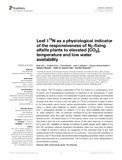Leaf δ15N as a physiological indicator of the responsiveness of N2-fixing alfalfa plants to elevated CO2, temperature and low water availability
Fecha
2015Autor
Versión
Acceso abierto / Sarbide irekia
Tipo
Artículo / Artikulua
Versión
Versión publicada / Argitaratu den bertsioa
Impacto
|
|
10.3389/fpls.2015.00574
Resumen
The natural 15N/14N isotope composition (δ15N) of a tissue is a consequence of its N source and N physiological mechanisms in response to the environment. It could potentially be used as a tracer of N metabolism in plants under changing environmental conditions, where primary N metabolism may be complex, and losses and gains of N fluctuate over time. In order to test the utility of δ15N as an ind ...
[++]
The natural 15N/14N isotope composition (δ15N) of a tissue is a consequence of its N source and N physiological mechanisms in response to the environment. It could potentially be used as a tracer of N metabolism in plants under changing environmental conditions, where primary N metabolism may be complex, and losses and gains of N fluctuate over time. In order to test the utility of δ15N as an indicator of plant N status in N2-fixing plants grown under various environmental conditions, alfalfa (Medicago sativa L.) plants were subjected to distinct conditions of [CO2] (400 vs. 700 μmol mol−1), temperature (ambient vs. ambient +4°C) and water availability (fully watered vs. water deficiency—WD). As expected, increased [CO2] and temperature stimulated photosynthetic rates and plant growth, whereas these parameters were negatively affected by WD. The determination of δ15N in leaves, stems, roots, and nodules showed that leaves were the most representative organs of the plant response to increased [CO2] and WD. Depletion of heavier N isotopes in plants grown under higher [CO2] and WD conditions reflected decreased transpiration rates, but could also be related to a higher N demand in leaves, as suggested by the decreased leaf N and total soluble protein (TSP) contents detected at 700 μmol mol−1 [CO2] and WD conditions. In summary, leaf δ15N provides relevant information integrating parameters which condition plant responsiveness (e.g., photosynthesis, TSP, N demand, and water transpiration) to environmental conditions. [--]
Materias
Alfalfa,
Climate change,
Growth,
delta15N,
Physiology
Editor
Frontiers Media
Publicado en
Frontiers in Plant Science, 6: 574
Departamento
Universidad Pública de Navarra. Departamento de Estadística e Investigación Operativa /
Nafarroako Unibertsitate Publikoa. Estatistika eta Ikerketa Operatiboa Saila /
Universidad Pública de Navarra. Departamento de Ciencias del Medio Natural /
Nafarroako Unibertsitate Publikoa. Natura Ingurunearen Zientziak Saila /
Universidad Pública de Navarra/Nafarroako Unibertsitate Publikoa. IdAB. Instituto de Agrobiotecnología / Agrobioteknologiako Institutua
Versión del editor
Entidades Financiadoras
This work was supported by the Spanish Economy and Competiveness ministry (AGL-2012-37815-CO5-05, AGL2011-30386-C02-02 and Ramón y Cajal research grant) and by the Portuguese FCT (PTDC/BIA-ECS/122214/2010). IA was supported by a postdoctoral Fellowship from the Government of Navarra (Anabasid outgoing Programme) and by a postdoctoral Fellowship from the Portuguese FCT (SFRH/BPD/90436/2012).
Aparece en las colecciones
Los documentos de Academica-e están protegidos por derechos de autor con todos los derechos reservados, a no ser que se indique lo contrario.
La licencia del ítem se describe como © 2015 Ariz, Cruz, Neves, Irigoyen, Garcia-Olaverri, Nogués, Aparicio-Tejo and Aranjuelo. This is an open-access article distributed under the terms of the Creative Commons Attribution License (CC BY). The use, distribution or reproduction in other forums is permitted, provided the original author(s) or licensor are credited and that the original publication in this journal is cited, in accordance with accepted academic practice. No use, distribution or reproduction is permitted which does not comply with these terms.







